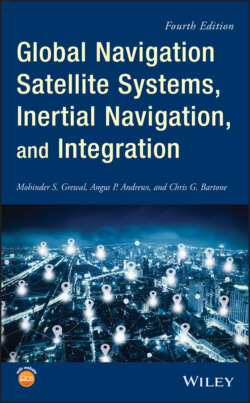Читать книгу Global Navigation Satellite Systems, Inertial Navigation, and Integration - Mohinder S. Grewal - Страница 121
3.5.1.3 Initializing ISA Attitude
ОглавлениеGyrocompassing. Gyrocompass alignment of stationary vehicles uses the sensed direction of acceleration to determine the local vertical and the sensed direction of rotation to determine north, as illustrated in Figure 3.13.
Using auxiliary sensors. Non‐gyroscopic attitude sensors can also be used as aids in alignment. These include the following:
Figure 3.13 Gyrocompassing determines sensor orientations with respect to east, north, and up.
Magnetic sensors are used primarily for coarse heading alignment, to speed up INS alignment.
Star trackers are used primarily for space‐based or near‐space applications. The Snark cruise missile and the U‐2 spy plane used inertial‐platform‐mounted star trackers to maintain INS alignment on long flights, an idea attributed to Northrop Aviation.
Optical alignment systems have been used on some systems prior to launch. Some use Porro prisms mounted on the inertial platform to maintain optical line‐of‐sight reference through ground‐based theodolites to reference directions at the launch complex.
Quasi magnetostatic sensors have been used in virtual reality systems for determining the attitude and position of the headset relative to its environment. These use three orthogonal and independently coded low‐to‐medium frequency magnetic dipole sources to illuminate the local area where rotational and locational orientation data is required, and three‐axis AC magnetic sensors as receivers.
